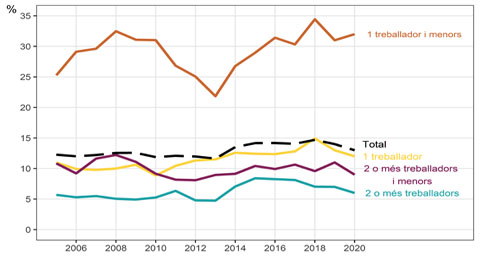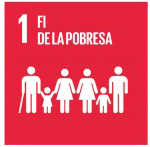Working poverty concentrated in single earner households with children
According to a study published today by the UAB and the Centre for Demographic Studies (CED-CERCA), 32% of households with children and only one single earner are poor. "Even if there is someone working, they cannot rise out of poverty", researchers alert. Spain has the second highest working poverty rate in Europe.

A study by the UAB and the CED-CERCA, published today in Perspectives Demogràfiques, entitled "El pes de la precarietat laboral en la pobresa de les llars amb menors" [The Weight of Working Precariousness in Households with Minors], analyses the relation between working poverty and child poverty, a relation that has not been studied much in Spain until now.
Spain has one of the highest working poverty rates in all of the European Union, a rate which has remained relatively stable: between 12% and 15% of all households with earners live in poverty. Despite a slight reduction between 2018 and 2020, Spain continues to be the second country in the EU with the highest rate of working poverty, surpassed only by Rumania. Not only that, but there is also an elevated rate of childhood poverty: according to data from Eurostat, almost one out of every three children lives in poverty.
Based on the data made available by the Living Conditions Survey (2017-2020), CED-CERCA researchers Alba Lanau and Mariona Lozano, concluded in their study that working poverty and childhood poverty were closely linked. The study points out that working poverty in Spain is concentrated in households with minors, and particularly in those with choildren and in which only one of the adults is working: 32% of these households lives in poverty. "There are homes, especially those with children, in which even if one of the members works, they continue to be poor", alerts researcher Alba Lanau.
According to the study, "the loss or decrease in wages of an adult increases the risk of poverty in a context in which two salaries are often necessary to avoid falling into poverty", and at the same time researchers highlight that "numerous scientific studies remark the difficulties mothers find to enter or stay in the labour market, as well as pointing to the link between maternity and lower salaries".
How to rise out of poverty?
The probability of leaving poverty behind in households with no children and in which the person working has a stable employment is 43%, while the percentage falls to 26% when there are children in the household, and to 21% in homes with children in which the earner has a temporary job. And this difficulty also affects 8% of large families, those with three or more children.
"Neverthless, changes in the employment situation are more relevant than changes in the number of household members when it comes to understanding working and child poverty", the authors point out. Even when a growth in the number of children increases the chances of working poverty, only a small percentage, 4%, is associated with this factor.
In contrast, 39% of those ending up in working poverty coincide with a decrease in the number of household earners; 37% with a decrease in salary without the loss of employment (e.g., a temporary period of unemployment); and 29% experiment a reduction in unemployment benefits. "This last figure suggests that a number of poor households cannot make up for the loss of income after unemployment benefits run out or are reduced", highlights researcher Alba Lanau.
For the authors of the study, this situation suggests that "there must be an increase in the economic help for these households and strategies must be found to reduce working poverty by raising salaries and reducing precariousness". In this sense, she mentions the Child Guarantee Programme (Programa de Garantia Infantil), recently announced by the government and whose objective is to improve the conditions of households with children living in extreme poverty, and the fact that such programmes can be effective in reducing both child and working poverty.
ARTICLE:
"El pes de la precarietat laboral en la pobresa de les llars amb menors", Alba Lanau and Mariona Lozano. Perspectives Demogràfiques, num. 27. 2022. Centre d’Estudis Demogràfics, Universitat Autònoma de Barcelona.
The UAB, with Sustainable Development Goals
 No poverty
No poverty